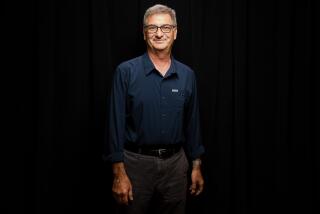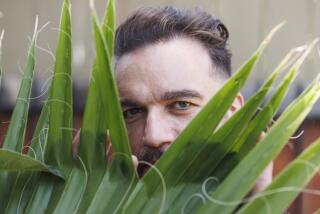Let ‘er Rot! : After 2 Years on the Compost Circuit, John Roulac’s Finally Finding Converts
John Roulac picks up a grocery box of wilted lettuce leaves and empties it into a large round plastic bin.
“Compost is like cooking,” he explains. “You start with a good recipe, you add different ingredients and you experiment with the mix until you get it right. Today we’ll teach you a few things about making a good compost pile.”
It is a Saturday morning in Santa Monica’s Clover Park, and Roulac, a boyish, bearded man in his 30s, wearing a baggy sweater, jeans and work shoes, is conducting a workshop. About 40 men and women, seated on park benches under a grove of Chinese elms, watch raptly as he adds a heap of dry leaves and wood chips to the mix.
“The basic idea is to use a balance of green materials--like grass clippings or vegetarian food scraps--which are high in nitrogen, and brown materials--like dry leaves and twigs--which provide carbon,” Roulac says, poking at the mix with a pitchfork. “The microorganisms which help the process of decomposition like two things--food and water.”
He throws in a pinch of paper (“but no stacks of newspapers or plastic bags”), adds water and stirs until light and fluffy. “If you come back in four days, it will be so hot you can’t touch it,” he tells his audience. “If you turn it every few days, you’ll have compost in a couple of months--so rich you can use it for potting soil.”
Roulac is on the workshop circuit, promoting composting, a natural recycling process whose practitioners range from the practical, “Let ‘er rot!” school to those disciples who see the breakdown of garbage and waste into nutritious soil as the essence of nature’s miraculous and ongoing transformation.
For Roulac, who belongs in the latter category and wants to teach the world to compost, 1991 was a turning point.
His new book, “Backyard Composting,” a collaborative effort in which dozens of experts are credited for their help, got a top review from both the American Library Assn. Booklist and Resource Recycling Magazine. The first printing of 15,000 has already sold out to bookstores, which are receiving their shipments this month.
Not only was Roulac’s book launched in 1991, but his dogged campaign for municipal composting programs began to take effect. Waste management officials throughout the Los Angeles area unveiled an advance guard of pilot projects aimed at keeping lawn clippings and table scraps at home.
“Last year people talked a lot about composting,” says Roulac. “In 1992 they will start rolling out the programs. Santa Monica has a program going; so do Glendale and Burbank and Ventura. Los Angeles is getting ready. The landfill crisis all over America is forcing cities into compost programs.”
That scenario might not excite everybody, but for Roulac it means that his fledgling career is starting to get off the ground.
“My dream has been to make a living at something that would help the planet, not pollute it,” says Roulac, who launched Harmonious Technologies in a small office in Pasadena in 1987.
From his original mission of promoting ecologically sound technologies to Southern California cities, he has narrowed his focus to composting, which he discusses with near-reverence, ticking off the many advantages of back-yard composting, explaining how kids love to watch a banana peel slowly convert to humus, citing examples of apartment composting and assembling teams of experts for his educational workshops.
Roulac views a compost heap--in which dead leaves, twigs, coffee grounds and carrot tops decompose into rich, crumbly soil--as the ultimate environmental symbol, a simple process that teaches people to restore and care for their own little corner of the planet.
Although he started concentrating on composting two years ago, he hadn’t gotten much attention until the last six months, he says: “The cities wanted to get their curbside recycling programs going first.”
Now the time seems right. Spurred by a 1989 state law mandating that cities reduce trash 25% by 1995 and 50% by 2000, California’s cities are targeting yard clippings, which make up 30% of landfill bulk. The notion of recycling yard waste into free fertilizer instead of lugging it to the landfill is a friendly one all around.
Recyclers like the hands-on aspects of composting compared to recycling cans and bottles. “You don’t just stick it out at the curb and it goes away,” says Santa Monica’s Jon Root, who is coordinating the city’s first big push into back-yard composting. “You see it being transformed.”
In Burbank, Public Works Administrator Joy Hamilton observes that “everybody’s working on compost projects.”
Like most cities, Burbank started with a pilot volunteer program that, she says, “is getting tremendous response.” The next step calls for funding of a 9,000-household program.
If Burbank reaches its goal of 50% household participation, it will save 6,000 to 10,000 tons of trash a year, she calculates.
Burbank has used Roulac’s consulting services, she says: “He’s been knocking on everybody’s door. But he didn’t have to sell us. We’ve known for some time that composting is the way to go. Working with John has made it easy for us.”
Roulac’s persistent sleeve-tugging has paid off in other cities. Says Tom Brady, Glendale’s integrated waste planner: “We definitely would not be doing this yet if John hadn’t pushed us. We would have done it eventually, but this is a field that needs advocates. John isn’t the scientist some others are, but he’s put together a good team.”
Glendale started with workshops for 500 households. “We distributed 375 bins last year and have been dribbling them out since then,” says Brady, whose concern is finding the best model in the growing supply of wood, fiberglass, plastic, round, square, stacked, open-air, closed-air and rotating-drum models. “We have five kinds and provide them free if households will fill out our survey.”
And in Ventura, which has been conducting workshops for the last five months, recycling coordinator Eric Werbalowsky likes Roulac’s book so much that he throws in a copy for every resident who buys a compost bin.
“There’s a big future in composting: we market it locally as the ‘next wave in recycling,’ ” he adds.
Roulac, 32, hopes so.
“I’m barely making a living at it,” he says between Saturday workshop sessions, over a health-food lunch of tossed salad and carrot juice. “It’s been a hard go, but ’92 looks promising.”
His quiet manner belies his persistence as an environmental salesman. “I became aware of the environment as a kid,” he says. “I grew up in Pasadena but spent a lot of time in the Pacific Northwest. We’d come back from a camping trip in the lush, green forests of Vancouver to the smog of Pasadena, and it was a split that just didn’t make sense.”
After graduating from San Marino High School, he attended a few classes at Pasadena City College. “I was bored in the classroom but loved the library,” he says. “I wanted to combine the environment and business.”
He worked on organic farms in Northern California, sold energy-efficient insulation for a while and started digging through environmental journals and attending conferences on environmental technology.
“My goal is for people to change their habits,” he says. “I want to create a composting society.”
By the end of his workshop day in Santa Monica, he can claim a few dozen converts. “I’ve just become a believer,” announces Michael Risman, a financial salesman who had noticed the workshop sign while driving by and stopped to hear Roulac’s pitch.
“I’m not what you’d call an environmental activist. I have four kids and coach a baseball team and don’t have a lot of spare time,” Risman says as he lines up to buy a compost bin. “But I have been aware of how we cut all this grass and put it out in blue containers and trucks haul it to the landfill. That takes a lot of energy. It strikes me there’s got to be a better system.”






